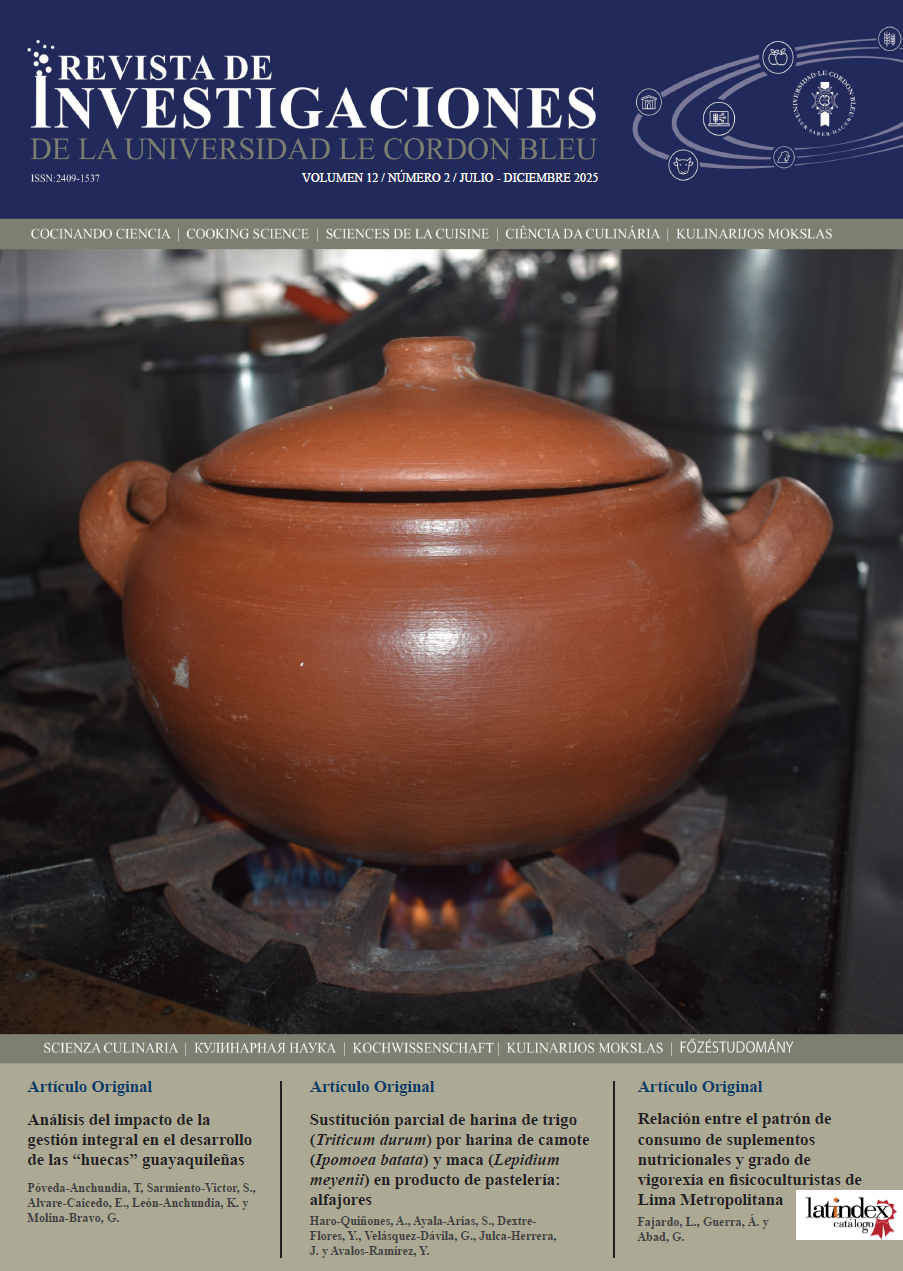Association between nutritional supplement intake patterns and the level of muscle dysmorphia in bodybuilders from in metropolitan Lima
Main Article Content
Abstract
In the world of bodybuilding, there is a high prevalence of muscle dysmorphia due to the pressure that participants in this discipline are subjected to. Strict diets, long training sessions, and the use of ergogenic aids can trigger an obsession that can negatively impact an individual's psychosocial level. The objective of this research was to determine the relationship between the pattern of nutritional supplement consumption and the degree of muscle dysmorphia in bodybuilders from metropolitan Lima. The research approach was a non-experimental, correlational, and prospective cross-sectional approach. The sample consisted of 30 bodybuilders from Lima who were administered the "Adonis Complex Questionnaire" to determine their degree of muscle dysmorphia and the "Nutritional Supplement Pattern Questionnaire." All bodybuilders presented some degree of muscle dysmorphia: 53% moderate, 30% severe, 10% pathological, and 7% mild. All of them consumed nutritional supplements, primarily creatine (57%) and protein powder (54%). However, no statistically significant relationship was observed between supplement consumption patterns and the degree of muscle dysmorphia in bodybuilders from metropolitan Lima.
Downloads
Article Details

This work is licensed under a Creative Commons Attribution 4.0 International License.
References
Alejo, H., et al. (2021). Consumo de suplementos nutricionales en personas que se ejercitan en gimnasios del norte de México. Revista Médica del Instituto Mexicano del Seguro Social, 58(6), 650-656. https://www.redalyc.org/journal/4577/457769357003/457769357003.pdf
American Psychiatric Association. (2014). Diagnostic and statistical manual of mental disorders (5th ed.). American Psychiatric Association
Australian Sports Commission. (s. f.). Supplements. Australian Institute of Sport. https://www.ausport.gov.au/ais/nutrition/supplements
Bermúdez, V. (2023). Consumo de suplementos nutricionales en personas que realizan crossfit en Amba, durante el año 2022. [Tesis para optar Licenciatura en Nutrición]. Repositorio institucional RID ISALUD. http://repositorio.isalud.edu.ar/xmlui/bitstream/handle/123456789/572/TFN613.71%2 0B456.pdf?sequence=1&isAllowed=y
Cafri, G., Olivardia, R., & Thompson, J. K. (2008). Symptom characteristics and psychiatric comorbidity among males with muscle dysmorphia. Comprehensive Psychiatry, 49(4), 374–379. 10.1016.https://doi.org/10.1016/j.comppsych.2008.01.003
Cooper, M., et al. (2020). Muscle dysmorphia: A systematic and meta-analytic review of the literature to assess diagnostic validity. International Journal of Eating Disorders, 53(10), 1583–1604. https://doi.org/10.1002/eat.23349
Devrim A, Bilgic P, Hongu N. ¿Existe alguna relación entre la percepción de la imagen corporal, los trastornos alimentarios y los trastornos dismórficos musculares en culturistas masculinos? American Journal of Men's Health . 2018;12(5):1746-1758. doi: 10.1177/1557988318786868
Ganson, K. T., Testa, A., & Nagata, J. M. (2024). Creatine monohydrate use is prospectively associated with muscle dysmorphia symptomatology. Eating behaviors, 54, 101910. https://doi.org/10.1016/j.eatbeh.2024.101910
Gauciry, B., Becerrin H., Paredes, Y., Holod, M. (2019). Relación de la frecuencia del consumo de suplementos nutricionales con el propósito y el sexo de los usuarios en un gimnasio en Mérida 2018. Revista GICOS. 4(1),16-24. http://bdigital2.ula.ve:8080/xmlui/bitstream/handle/654321/2915/15206-%2021921930450-1-PB.pdf?sequence=1&isAllowed=y
Gómez F. (2017). Consumo de suplementos nutricionales en los gimnasios de Talavera De la Reina. Universidad Francisco De Vitoria [Tesis de pregrado, Universidad Francisco de Vitoria]. Repositorio institucional de la Universidad de la Universidad Francisco de Vitoria http://ddfv.ufv.es/bitstream/handle/10641/1577/Guillermo%20Freddy%20-%20Consumo%20de%20suplementos%20nutricionales%20en%20los%20gimnasios %20de%20Talavera%20De%20la%20Reina.pdf?sequence=1&isAllowed=y
González García, L., Brito Llera, A., Robles Najarro, A., & Garcés García-Espinosa, L. (2021). Sobre las relaciones entre el riesgo de vigorexia y el consumo de productos ergogénicos en gimnasios de la ciudad de La Habana. Revista Cubana De Alimentación Y Nutrición, 31(1), 21. https://revalnutricion.sld.cu/index.php/rcan/article/view/1096/pdf
Hinojosa, C. (2020) Vigorexia en los gimnasios de Teruel [Trabajo de fin de carrera, Colegio Oficial de Teruel]. http://comteruel.es/ojs/index.php/atalaya/article/view/295/322
Lambert, C. P., Frank, L. L., & Evans, W. J. (2004). Macronutrient considerations for the sport of bodybuilding. Sports medicine (Auckland, N.Z.), 34(5), 317–327. https://doi.org/10.2165/00007256-200434050-00004
Latorre-Román, P. Á., Garrido-Ruiz, A., & García-Pinillos, F. (2014). Versión española del cuestionario del complejo de Adonis; un cuestionario para el análisis del dimorfismo muscular o vigorexia [Spanish version of Adonis Complex Questionnaire. A questionnaire to test the muscle dimorphism and vigorexy]. Nutricion hospitalaria, 31(3), 1246–1253. https://doi.org/10.3305/nh.2015.31.3.8292
Moradi, F., Yazdani, A., Nematolahi, F., Hosseini-Roknabadi, S. M., & Sharifi, N. (2024). Prevalence of supplement usage and related attitudes and reasons among fitness athletes in the gyms of Kashan and its relationship with feeding behavior: a cross-sectional study. BMC sports science, medicine & rehabilitation, 16(1), 150. https://doi.org/10.1186/s13102-024-00940-3
Villavicencio, W. (2018). Guía de Diseño de Instalaciones Deportivas. Recuperado el 20 de agosto del 2022. https://waltervillavicencio.com/wp-content/uploads/2018/06/FISICO- CULTURISMO-Y-FITNESS.pdf
